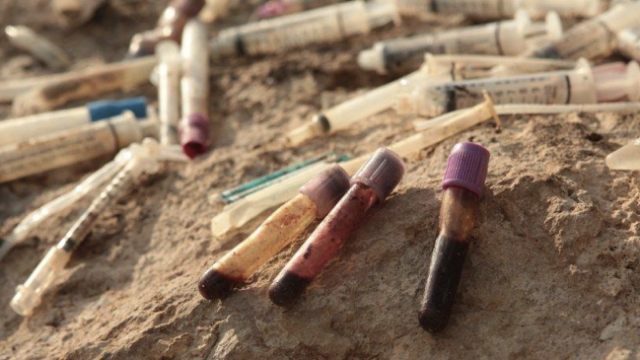Waste Management of Hawaii, others indicted for 2011 ocean contamination

THOSE AREN’T SEASHELLS: Medical Waste washing up on Oahu’s west shore.
By Malia Zimmerman | Watchdog.org
HONOLULU — Some 7.5 million gallons of contaminated water, toxic soil, trash, fecal matter and human medical waste poured into west Oahu’s ocean waters on Jan. 13, 2011 from the Waimanalo Gulch Sanitary Landfill managed by Waste Management of Hawaii.
Just over three years later, a federal grand jury has returned a 13-count indictment charging Waste Management of Hawaii, the company’s general manager and vice president Joseph R. Whelan and environmental protection manager Justin H. Lottig with multiple felonies, including “violations of the Clean Water Act, conspiracy and making false statements to the Hawaii Department of Health and the U.S. Environmental Protection Agency.”
The event, deemed an “environmental catastrophe” by local environmentalists, led to the temporary shutdown of Waimanalo Gulch Sanitary Landfill, Oahu’s only public landfill. Beach closures also impacted thousands of residents on the west side of Oahu and the prestigious Ko’Olina Resorts.
The Wednesday indictment alleges that from April 19, 2010 until Dec. 23, 2010, “Justin Lottig conspired with employees from an environmental consulting firm to submit false and outdated information to the Department of Health Clean Water Branch in June, August and September 2010. The purpose of the conspiracy was to convince Department of Health Clean Water Branch that the landfill had an adequate storm water management system in place in order to renew its storm water discharge permit.”
The indictment also alleges that from Oct. 27 to Dec. 23, 2010, Lottig and Waste Management of Hawaii “violated the permit by knowingly failing to inform the Department of Health Clean Water Branch of material changes in the storm water management system that would have alerted the Department of Health Clean Water Branch that an inadequate system was in place.”
The company issued a statement acknowledging the indictment of Waste Management of Hawaii and two employees as defendants.
“We believe there is no basis for these charges by the U.S. Attorney’s Office and we intend to vigorously defend against this extraordinary action,” Waste Management said. “Safety, ethics and environmental protection are core beliefs of our business at Waste Management and we operate our facilities with the utmost regard for the health and safety of employees, neighbors and the environment.”
Lyle Hosoda, attorney for Lottig, called the indictment a “misjudgment” by the U.S. Attorney’s Office, and the charges, “baseless and unwarranted.”
“Charging an employee with crimes for simply going to work and exercising his best efforts and judgments to try to manage and prevent further damage and disaster in the face of an unprecedented amount of stormwater is revolting, and cause for alarm and concern for all employees, everywhere,” Hosoda said. “Mr. Lottig and all of the employees of WMH are and continue to be committed to lawfully and responsibly handling our community’s waste, while protecting our land and ocean. They did so and continue to do so, even in the face of both rain and political storms.”
In 2011, the city, state and Waste Management reported the trash breach was caused when a “100-year storm” and a “catastrophic weather event” hit Oahu on January 13. More than 11 inches of rain fell in 24 hours in an area that usually gets 19 inches annually.
According to the indictment, “the storm water was required to go through the landfill’s storm water management system to ensure that it did not come into contact with waste in the landfill before being discharged to Hawaii’s coastal waters. The NPDES permit prohibited WMH from causing or contributing to a violation of Hawaii’s state water quality standards.”
Environmental Watchdog Carroll Cox scoured the coastline after the trash breach, collecting and photographing medical waste and dangerous chemicals.
He maintains the environmental catastrophe was not due to what Waste Management and the government called the “storm of the century”, but rather is due to mismanagement.
“We warned the DOH and public that something like this just might happen … after the first heavy storm in late December, when we found large sheets of landfill liner in the outfall by the ocean and in the stream. We reported evidence that cell E6 in the Waimanalo Gulch Landfill had been damaged and an overflow occurred. This was surely signs of problems to come,” said Cox, who helped federal investigators with their case.
The city and county of Honolulu and the State Department of Health should also be held accountable, Cox said, because the city is the owner of the landfill and the DOH is the regulatory body.
“We believe … Honolulu should immediately cancel its contract with Waste Management and obtain the services of another company. We also believe the Health Department should hire at least two trained engineers with expertise in landfills,” Cox said.
Waste Management of Hawaii, in addition to operating the Waimanalo Gulch Sanitary Landfill for Honolulu, also operates West Hawaii Sanitary Landfill for the county of Hawaii and Kekaha Landfill for the county of Kauai, handling municipal solid waste.
Following the indictment, Honolulu environmental director Lori Kahikina said Honolulu will continue to cooperate with the parties in their investigation of the 2010 and 2011 floods of the Waimanalo Gulch Sanitary Landfill and the discharge of waste into the ocean resulting from the 2011 flood.
“Corrective measures have been taken to protect against such an event recurring, and the city is satisfied with the ongoing operations of the landfill. As the matter is in litigation, the city has no further comment.”
Reach Malia Zimmerman at Malia@hawaiireporter.com







